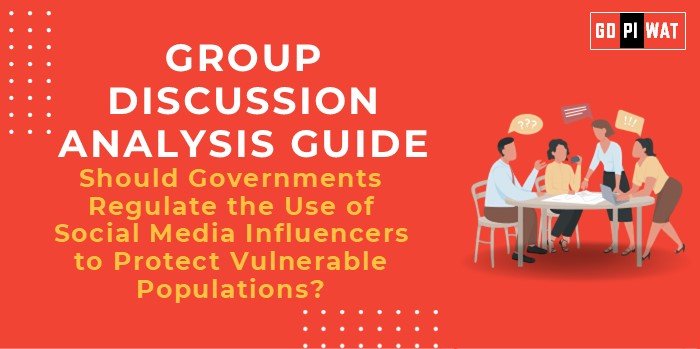📋 Group Discussion (GD) Analysis Guide
Should Governments Regulate the Use of Social Media Influencers to Protect Vulnerable Populations?
🌐 Introduction to the Topic
Opening Context: Social media influencers shape consumer behavior, opinions, and even lifestyles, wielding significant power over their audiences. Governments worldwide are now debating whether regulation is necessary to mitigate risks to vulnerable populations, such as minors, individuals with low media literacy, or those exposed to harmful content.
Topic Background: The rise of social media influencers has created a new era of digital marketing, where trust and relatability often surpass traditional advertising. However, unchecked promotions, misinformation, and exploitation of trust have led to calls for stronger oversight. Countries like Australia and the UK are considering or implementing regulations for greater transparency.
📊 Quick Facts and Key Statistics
- Influencer Marketing Growth: Expected to reach $21 billion by 2024, highlighting its rapid expansion.
- Youth Impact: Over 50% of teenagers purchase products based on influencer recommendations (Pew Research, 2023).
- Harmful Content Risk: Studies show a 30% increase in body dissatisfaction linked to unrealistic influencer portrayals (Journal of Media Psychology, 2023).
- Global Regulation Trends: Nations like Norway now mandate disclaimers for retouched images in influencer content.
🔗 Stakeholders and Their Roles
- Governments: Enforce laws on transparency, child protection, and content accuracy.
- Social Media Platforms: Provide tools for content labeling and enforce community guidelines.
- Influencers: Maintain ethical standards, adhere to disclosure norms, and avoid harmful content.
- Audiences: Educate themselves and demand accountability.
🏆 Achievements and Challenges
Achievements:
- Increased Transparency: Mandatory labeling of sponsored content in several countries (e.g., the UK Advertising Standards Authority regulations).
- Awareness Campaigns: Successful initiatives promoting mental health awareness by influencers.
- Ethical Advertising Growth: Brands prioritize partnering with influencers adhering to disclosure norms.
Challenges:
- Misinformation Spread: Lack of verification for influencer claims (e.g., health supplements).
- Youth Vulnerability: Exposure to harmful or inappropriate content.
- Regulation Enforcement: Difficulty in monitoring global platforms effectively.
Global Comparisons: Australia enforces stricter laws for influencer marketing in the health and wellness sector. Norway mandates disclaimers for retouched images, aiming to reduce unrealistic body standards.
📖 Structured Arguments for Discussion
- Supporting Stance: “Government regulation ensures transparency and protects vulnerable groups from exploitation.”
- Opposing Stance: “Overregulation may stifle creativity and economic opportunities for influencers.”
- Balanced Perspective: “While regulations are necessary for transparency and safety, they should be balanced to allow creative freedom.”
💡 Effective Discussion Approaches
Opening Techniques:
- Use Statistics: “With influencer marketing expected to hit $21 billion by 2024, the need for oversight is evident.”
- Cite Case Studies: “Norway’s approach to influencer transparency shows a possible way forward.”
Counter-Argument Handling:
- Highlight creative solutions, such as self-regulatory bodies.
- Emphasize global examples to balance criticism.
📊 Strategic Analysis of Strengths and Weaknesses
- Strengths: Drives accountability, reduces misinformation, protects vulnerable populations.
- Weaknesses: Risk of overreach, enforcement challenges, potential economic impact.
- Opportunities: Collaborations with platforms for self-regulation, global standard-setting.
- Threats: Resistance from industry players, unintended consequences of overregulation.
🔗 Connecting with B-School Applications
- Real-World Applications: Policy development in digital marketing ethics and exploring regulatory frameworks in business strategy.
- Sample Interview Questions:
- “How can governments strike a balance between regulation and creative freedom?”
- “What lessons can India learn from countries like Norway or Australia in regulating influencers?”
- Insights for Students:
- Understand how ethical marketing influences consumer trust.
- Explore intersections between law, digital media, and business strategy.


